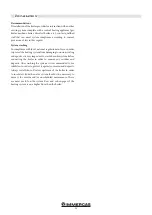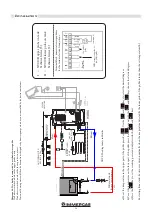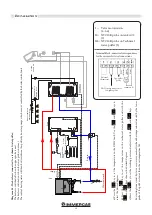
16
Installation
TECHNICAL FEATURES
The flue that services a pellet device must meet the following
requirements:
• be made with materials that can withstand mechanical
stress, heat, action of combustion products and their
condensate over time.
• be made with waterproof materials against flue gas,
condensate, thermally insulated and suitable to withstand
normal mechanical stress over time
• have a vertical performance with axis deviations not
exceeding 45° and without constrictions
• Must be suitable for specific operating conditions of
the product and provided with CE marking (EN1856-1,
EN1443).
• Be sized correctly in order to meet the flue gas draught/
disposal required to regulate product operation (EN13384-1)
• Be adequately insulated to prevent condensate and reduce
the effect of flue cooling.
• Must be minimum category T400 and withstand soot fire.
In particular, it is recommended to check the data plate of the
flue (according to EN1856-1, EN1443) for the safety distances
that must be respected in the presence of or passing through
of combustion materials and the type of insulating material to
use. These provisions must be strictly complied with in order
to prevent serious harm to one’s health and safeguard the
integrity of the building.
The chimney’s opening must be in the same room in which
the appliance is installed or, at most, in the adjacent room, and
to install a soot and condensate collection chamber under the
opening, which can be accessed from the metal sealed door.
DIMENSIONING
The negative pressure (draught) of a flue also depends on its
height.
Use suitable tools to check that draught is between 8 Pa and
15 Pa.
The internal section of the flue can be round (it is the best),
square or rectangle (the ratio between the internal sides must
be ≤1.5) with the sides connected with a minimum 20 mm
radius.
The sections/lengths of the chimneys listed in the technical data
table are indications for correct installation. Any alternative
configurations must be correctly dimensioned according to
the general calculation method regarding UNI EN13384-1 or
other approved efficiency methods.
Below are a few examples of flues available on the market:
AISI 316 steel
chimney with
double insulated
chamber with
ceramic fibre
or equivalent
resistance up to
400°C.
Refractory
chimney with
double insulating
chamber and
external sleeve
in lightweight
concrete made
from a clay type
of honeycomb
material.
Traditional square
clay chimney with
empty insulating
inserts.
Avoid chimneys
with internal
rectangular
sections whose
ratio between
the largest and
smallest side is
greater than 1.5
(e.g. 20x40 or
15x30).
VERY GOOD
GOOD
AVERAGE
POOR
















































